About
Research in the laboratory focuses on developing nanoscale tools to study biological systems. These tools include instrumentation based on proximity probes, such as electrochemical tunnelling microscopy and spectroscopy and single molecule force spectroscopy, that we apply to investigate electron transfer in individual redox proteins, and other biophysical and biochemical interactions.
These studies are relevant to understand lipid membrane dynamics, to the development of biosensors and molecular electronics devices, and have led to the discovery of long-distance electrochemically gated electron transport between partner proteins of the respiratory and photosynthetic chains.
Another set of nanotools that we are developing is based on engineered molecular actuators that can be switched with light, such as azobenzene, which can be chemically attached to biomolecules in order to remotely control their activity (photopharmacology). They include peptide inhibitors of protein-protein interactions, small molecule enzymatic inhibitors, and photoswitchable ligands of a diversity of other proteins.
Among several applications, these compounds have enabled photoactivated chemotherapy, photocontrol of cellular signaling mediated by ion channels and G protein-coupled receptors, photocontrol of cardiac activity and locomotion, sensory restoration, and photocontrol of brain waves.
Based on these tools, we have also developed two-photon pharmacology to manipulate and study the activity of neurons and glia in intact brain tissue with pharmacological selectivity and sub-cellular three-dimensional resolution.
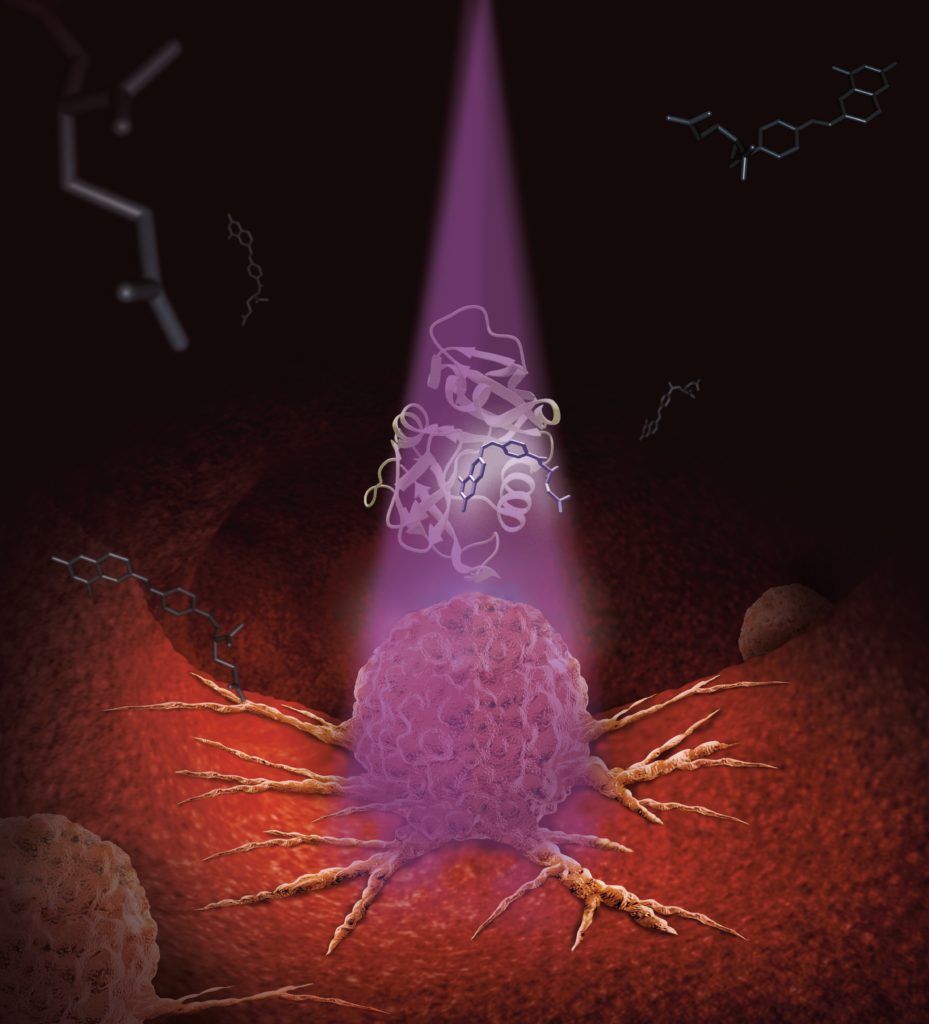

Staff
CURRENT STAFF
Pau Gorostiza Langa
ALUMNI LIST
- Dr. Juan Manuel Artés. Assistant Professor at the University of Massachusetts at Lowell.
- Dr. Marisabel Bahamonde-Santos. Postdoctoral researcher at the Hospital Clínic, University of Barcelona.
- Dr. Antonio Bautista. Data scientist at the data science and analytics company Le Wagon in Bordeaux.
- Dr. Miquel Bosch. Assistant Professor at the International University of Catalonia in Barcelona.
- Dr. Amir Broomand.
- Dr. Rossella Castagna. Assistant Professor at the Latvian Institute of Organic Chemistry in Riga and in the Politecnico di Milano.
- Dr. Aida Garrido-Charles. Alexander vonHumboldt postdoctoral fellow at the University of Göttingen.
- Dr. Alexandre Gomila-Juaneda. Postdoctoral fellow at the Forschungszentrum Jülich.
- Dr. Berta Gumí. Project manager at the clinical research consulting company Teamit in Barcelona.
- Dr. Mercè Izquierdo-Serra. Associate Professor at the University of Barcelona.
- Dr. Montserrat López-Martínez. Postdoctoral fellow at the Technical University of Vienna.
- Dr. Manuel López-Ortiz. Postdoctoral researcher at the University of Rostock.
- Dr. Andrés Martín-Quirós. Manager atthe technology consulting company EY in Barcelona.
- Dr. Carlo Matera. Associate Professor at the University of Milan.
- Dr. Silvia Pittolo. Marie Slodowska Curie postdoctoral fellow at the University of California in San Francisco and Max Delbrück Center in Berlin.
- Dr. Marta Pozuelo Ruiz
- Dr. Davia Prischich. Postdoctoral fellow at the Imperial College, London.
- Dr. Lorena Redondo-Morata. Researcher at the Pasteur Institute in Lille.
- Dr. Fabio Riefolo. Project manager at the clinical research consulting company Teamit in Barcelona.
- Dr. Ricardo Zamora Brito
Undergraduates, master students, and other researchers
- Luca Agnetta, Visiting Researcher
- Adam Ali Dahbi Skali, Masters Student
- Maria Elena Antinori, Masters Student
- Esther Argüelles Marcos, Research Assistant
- Blai Barberà Bertrans, Undergraduate Student
- Felipe Caballero Briones, Postdoctoral Researcher
- Eric Calatayud Gómez, Undergraduate Student
- Pablo Calvé Pérez, Masters Student
- Francesco Calzaferri, Masters Student
- Maria Cambra Pellejà, Undergraduate Student
- Àlex Carreté Bello, Masters Student
- Maria Casademont Cavero, Undergraduate Student
- Laura Casas Ferrer, Masters Student
- Pere Català Quilis, Undergraduate Student
- Alejandro Cebrián Ortiz, Undergraduate Student
- Àlvar Claparols Carrasco, Masters Student
- Adrián Crespo Villanueva, Masters Student
- Fernanda Da Silva Andrade, PhD Student
- Nadim Darwish, Postdoctoral Researcher
- Paula de Saralegui Cabot, Undergraduate Student
- Genís Del Pino Vives, Undergraduate Student
- Ismael Díez Pérez, Visiting Researcher
- Beatriu Domingo Tafalla, Masters Student
- Judit Donada Oliu, Masters Student
- Joël Donkeng Dazie, Visiting Researcher
- Jose Antonio Durán Mota, Masters Student
- Gustavo Echeveste, Masters Student
- Safae El Jellouli Bota, Undergraduate Student
- Victòria Englert González, High School / Voc. Training
- Míriam Ferrer Huerta, Masters Student
- Mattia Ferrero, Undergraduate Student
- Marta Forcella, Masters Student
- Coral Fustero Torre, Undergraduate Student
- Ignasi Garcia Ibañez, undergraduate
- Lídia García Guillamón, Undergraduate Student
- Hubert Gerwe, Visiting Researcher
- Irene Giménez Gonzalez, High School / Voc. Training
- Arnaud Giraudet, Undergraduate Student
- Alfredo Maria Gravagnuolo
- Iñigo Hierro Rivero, Masters Student
- Javier Hoyo Pérez, PhD Student
- Mariana Köber, Visiting Researcher
- Alvaro Lahiguera
- Michela Libergoli, Masters Student
- Lia Lima , Undergraduate Student
- Aaron Mañas Marin, Undergraduate Student
- Santiago Martin Solans
- Alejandro Martín Rodríguez, PhD Student
- Xavier Martínez Soler, Undergraduate Student
- Marta Masó Martínez, Masters Student
- Sònia Matencio Lloberas, Masters Student
- Debora Mazzetti, Masters Student
- Mireia Novell Cardona, Undergraduate Student
- Claudia Orabona Masters Student
- Sthefany Ortiz Tescari, Undergraduate Student
- Alissa Jayne Owen, Undergraduate Student (erasmus)
- Andras-Robert Pal Polgar, Undergraduate Student
- Anna Palacios Padrós, PhD Student
- Jaume Palou Fusté, Senior Researcher
- Claudio Papotto, Masters Student
- Laia Pasquina Lemonche, Masters Student
- Marina Pedrola Teixell, Undergraduate Student
- Sara Peña Gutiérrez, Undergraduate Student
- Deborah Pirovano, Masters Student
- Santiago Pons Allés, Masters Student
- Judit Prat Trunas, Undergraduate Student
- Beatrice Preda, Masters Student
- Guillermo Prol Castelo, Undergraduate Student
- Josecarlo Alejandro Quintanilla Ibarra, Undergraduate Student
- Cristian Ramos Guerra, Undergraduate Student
- Sara Redondi, Masters Student
- Ivan Rimmaudo
- Cristina Rivero Martí, Undergraduate Student
- Silvia Roda, Masters Student
- Karin Rustler, Masters Student
- Ewa Rzad, Undergraduate Student (erasmus)
- Júlia Sanz Farnós, Undergraduate Student
- Veronica Sarasso, Postgraduate Student
- Christian Seca, Undergraduate Student
- Silvia Sodric Hidalgo, Masters Student
- Karolina Szczesna, Undergraduate Student
- Maria del Carmen Torres Martín-Mora, Masters Student
- Iro Tsintzou, Masters Student
- Simone Vitiello, PhD Student
- Pamina Winkler, Visiting Researcher
- Daniel Wutz, PhD Student
Projects
| INTERNATIONAL PROJECTS | FINANCER | PI |
|---|---|---|
| DEEPER · Deep Brain Photonic Tools for Cell-type specific targeting of Neural diseases (2021-2025) | European Commission, ICT | Pau Gorostiza |
| Human Brain Project Specific Grant Agreement 3 (2020-2023) | European Commission, FET FLAGSHIPS | Pau Gorostiza |
| NATIONAL PROJECTS | FINANCER | PI |
|---|---|---|
| DEEP RED · Neuromodulación de las vías inhibitorias mediante fotofarmacología activada por luz roja e infrarroja (2020-2023) | MINECO, Retos investigación: Proyectos I+D | Pau Gorostiza |
| PRIVATELY FUNDED PROJECTS | FINANCER | PI |
|---|---|---|
| Drug4Sight · Light-regulated drugs to restore sight (2019-2022) | Obra Social La Caixa | Pau Gorostiza |
| FINISHED PROJECTS | FINANCER | PI |
|---|---|---|
| DECA CECH · Cluster Emergente del Cerebro Humano (2019-2021) | RIS3CAT – Tecnologies Emergents | Pau Gorostiza |
| SGR Grups de recerca consolidats (2017-2020) | AGAUR / SGR | Pau Gorostiza |
| Q-SPET · Quantum-controlled Single Protein Electron Transport (2019-2020) | BIST Ignite Program | Pau Gorostiza |
| Human Brain Project Specific Grant Agreement 2 (2018-2020) | European Commission, FET FLAGSHIPS | Pau Gorostiza |
| FOCUS Single Molecule Activation and Computing | ICT | Pau Gorostiza |
| THERALIGHT Therapeutic Applications of Light-Regulated Drugs | ERC-PoC | Pau Gorostiza |
| Single-BioET Single-molecule junction capabilities to map the electron pathways in redox bio-molecular architectures (2012-2016) | MARIE CURIE – RG | Ismael Díez |
| Optogenetic pacemaking to rewire neural circuits | La Marató TV3 | Pau Gorostiza |
| OPTOPHARMACOLOGY Aplicaciones terapéuticas de la optofarmacología | MINECO (CTQ2013-43892-R) | Pau Gorostiza |
| Milk fat globule membrane and periphera proteins: lipid-protein interactions (2016-2017) | Fausto Sanz | INRA |
| WaveScalES Human Brain Project Specific Grant Agreement 1 (2016-2018) | European Commission, FET FLAGSHIPS | Pau Gorostiza |
| OPTOFRAX Optopharmacological brain mapping of autism mouse (2015-2017) | MARIE CURIE – IF | Miquel Bosch |
| NANOPROSTHETICS Prótesis moleculares para restablecer la visión basadas en fotoconmutadores covalentes dirigidos (2016-2019) | MINECO, Retos investigación: Proyectos I+D | Pau Gorostiza |
| MODULIGHTOR Moduladores fotoconmutables sintéticos para manipular remotamente proteínas endógenas: fotocontrol in vivo de canales iónicos pentaméricos (2015-2018) | MINECO Nacional /Acciones de Programación Conjunta Internacional | Pau Gorostiza |
| nanoET-leukemia Nanoconductance of electron transfer proteins of the respiratory chain. Direct measurement at the single molecular level and therapeutic regulation in cancer stem cells (2015-2018) | MINECO, Proyectos RETOS 2015 / CIBER | Marina Giannotti / Anna Lagunas |
| Inhibición fotoselectiva de interacciones proteína-proteína para el estudio de redes interactómicas y el desarrollo de nuevas terapias (2015-2018) | Pau Gorostiza | Fundación Ramon Areces |
| Fotoconmutadores covalentes para el control remoto de receptores endógenos (2017-2019) | Pau Gorostiza | Convocatoria de Ayudas a la Investigación FUNDALUCE |
Publications
Equipment
- Asylum Research Molecular Force Probe
- Multimode SPM Nanoscope III (SCT-UB)
- Ivium and Autolab potentiostats
- Patch clamp setup with Heka EPC10 amplifier
- Molecular Imaging Electrochemical STM
- Zebrabox behavioral imaging system
- Tecan plate reader
Collaborations
- Prof. Ulrich Zeilhofer
University of Zürich - Prof. Tobias Moser
University of Göttingen - Dr. Mireia Oliva
Dept. de Farmàcia i Tecnologia Farmacèutica, Universitat de Barcelona - Niek van Hulst, Michael Krieg, Pablo Loza
Institut de Ciències Fotòniques (ICFO) - Carme Rovira
ICREA, Universitat de Barcelona - Pedro de la Villa
Universidad de Alcalá de Henares - Burkhard König
Regensburg University - Michael Decker
Regensburg University - Roberta Croce
Vrije Universiteit Amsterdam - Irene Díaz-Moreno, Miguel Ángel de la Rosa, Antonio Díaz-Quintana
Instituto de Investigaciones Químicas, Universidad de Sevilla - Jordi Hernando, Ramon Alibés, Félix Busque, Josep Maria Lluch
Universitat Autònoma de Barcelona, Spain - Maria Isabel Geli
Institut de Biologia Molecular de Barcelona
News

IBEC contributes to multi-disciplinary efforts to understand the brain and improve neurological healthcare
The Group of Pau Gorostiza at IBEC participates in the “Emerging Cluster of the Human Brain! (CECH) RIS3CAT Initiative, in which research institutes and industry work together to achieve an integrative and multi-level understanding of the human brain.
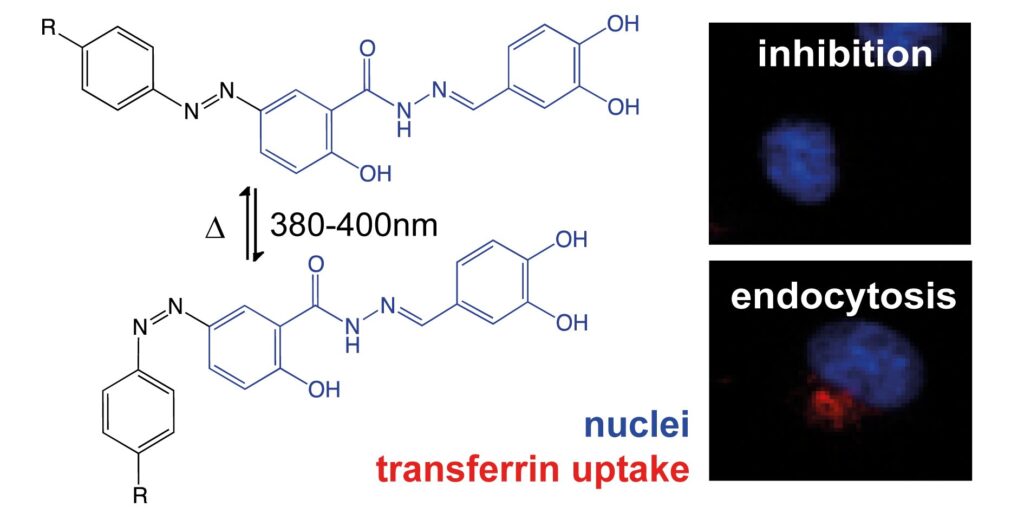
Lights, Cells, Action! IBEC develops small molecules able to control endocytosis with light
IBEC’s research group “Nanoprobes and nanoswitches” creates a system based on light to inhibit the endocytocis and control its spatio-temporal dynamics. The newly developed light-sensitive small-molecule inhibitors of endocytosis (called dynazos) are water-soluble, cell permeable, photostable, and enable fast photoswitchable inhibition of endocytosis. This technology will allow more accurate and controlled studies were endocytosis is crucial, as in cellular grow, differentiation and motility.
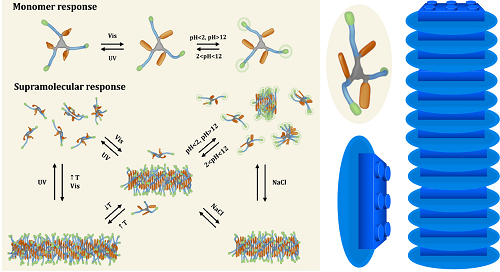
New chemical lego blocks for health solutions
IBEC researchers develop new multi-responsive molecules able to self-assemble in water forming fiber-like structures. The so-called discotic molecules show responsiveness to temperature, light, pH, and ionic strength and they might show great potential for medical applications such as drug delivery systems, diagnosis or tissue engineering. Edgar Fuentes is a PhD student in the Nanoscopy for Nanomedicine Group led by Lorenzo Albertazzi at the Institute for Bioengineering of Catalonia (IBEC). Within this group, Edgar and his colleagues focus on the synthesis of novel smart supramolecular materials for drug delivery.
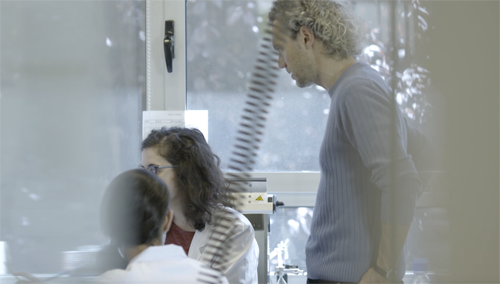
Can a light sensitive drug restore vision? Pau Gorostiza on BigVang
“We have achieved that blind fish recover their vision by adding a light-sensitive molecule to the tank’s water that has a pharmacological effect on their retina, ”explains Pau Gorostiza, ICREA researcher at IBEC, who has been working on the development of light regulated drugs for more than ten years.
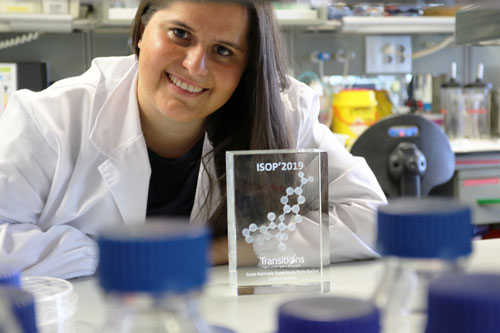
Rossella Castagna, postdoctoral researcher at IBEC wins the ISOP2019 prize
Rossella Castagna a postdoctoral researcher in the Nanoprobes and Nanowitches group at IBEC was awared with the ISOP2019 prize last week 9th International Symposium on Photochromism held in Paris. This recognition comes from her contribution to the field of photochromism and for the results that were collectively obtained in their group in the field of photopharmacology. Rossella presented the group results on photoswitchable drugs at the reference international meeting for photochromism, held every 3 years, where she was awarded with the conference prize. According to the organizing committee, such a prize rewards the most talented young researchers whose contribution is expected to notably impact the field of photochromism.
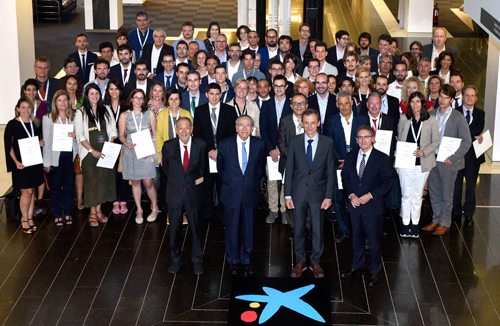
Three researchers from IBEC awarded with grants from “la Caixa” for their pioneering and high social impact research
José Antonio del Río, Pau Gorostiza, and Samuel Sánchez have been awarded in two of the “la Caixa” calls. José Antonio del Río, principal investigator of the Molecular and Cellular Neurobiotechnology Group at IBEC, is one of the winners of the second edition of the call for applications in biomedicine and health. Del Río’s project focuses on analysing the molecular mechanisms involved in the genesis and propagation of tau protein in brain cells. This protein is linked with several neurodegenerative processes and is present in numerous diseases such as Alzheimer’s. Pau Gorostiza, principal investigator of the Nanoprobes and Nanoswitches Group, also received an award at the second edition of the call for applications for research projects in biomedicine and health. In this case, for his project on degenerative eye conditions such as retinitis pigmentosa, which causes blindness due to the progressive degeneration of the cones and rods, which are the light sensitive cells.
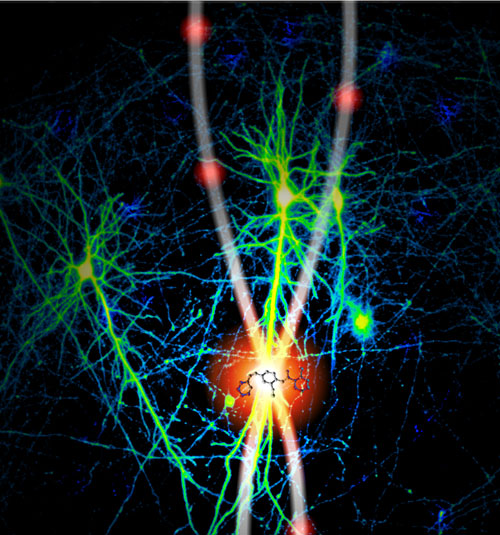
Closer to a functional atlas of the brain
Scientists from the Institute for Bioengineering of Catalonia develop a technique that enables them to work out the specific function of a neuronal receptor according to its location in the brain. The study, published in PNAS, is based on the activation of photoswitchable drugs with micrometric precision and offers new opportunities in neurobiology. Schizophrenia, depression, myasthenia… Many neurological diseases are due to the malfunctioning of a neuronal receptor. These proteins, also known as neuroreceptors, are responsible for sending and detecting neurotransmitters, chemical substances that allow communication between neurons.

ERC President visits IBEC
The President of the European Research Council, Jean-Pierre Bourguignon, visited last May 15th the Institute for Bioengineering of Catalonia (IBEC). The event was inaugurated by IBEC’s Director, Josep Samitier, who presented an overview on the cutting-edge research carried out at the institute in the fields of bioengineering and nanomedicine. Afterwards, ERC Grantees working at IBEC had the opportunity to explain the impact of ERC grants on their professional careers and established a dialogue with ERC President on the past, present and future of the European Research Council.
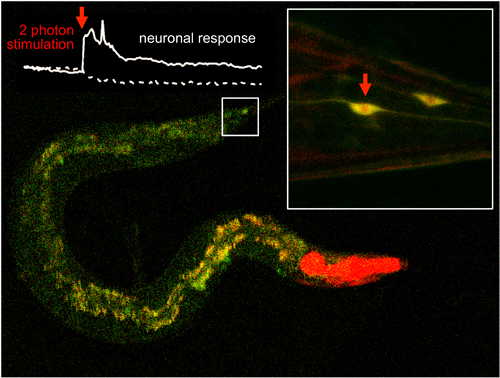
A new technique allows researchers to focus the action of drugs via infrared light
A scientific team led by IBEC and UAB manages to efficiently activate molecules located inside cell tissues using two-photon excitation of with infrared light lasers. The results of the study has been published in Nature Communications. Having absolute control of the activity of a molecule in an organism. Deciding when, where and how a drug is activated. These are some of the goals expected to be reached with the so-called photoswitchable molecules, compounds that, in the presence of certain light waves, change their properties. Today, thanks to the results of a study led by the Institute for Bioengineering of Catalonia (IBEC) together with the Universitat Autònoma de Barcelona (UAB), the scientific community is one step closer to achieving this objective.
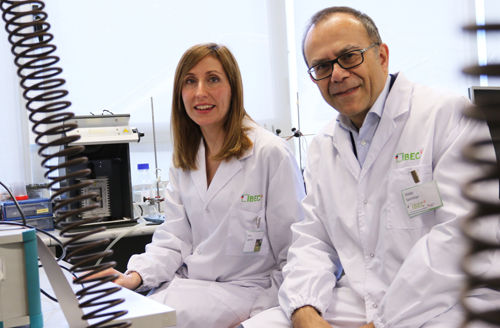
Proteins can transfer electrons at a distance
Collaborating IBEC groups have published a study in Nature Communications that reveals that electron transfer can take place while a protein is approaching its partner site, and not only when the proteins are engaged, as was previously thought. The results open up a new way of thinking about how proteins interact, and can have implications in a better understanding of many processes – such as photosynthesis, respiration and detoxification – in which electron transfer plays an important role. The relocation of an electron from one chemical entity to another – electron transfer (ET) – doesn’t happen passively: electrons are carried individually by redox proteins.
Jobs
We are happy to receive CVs and enquiries from talented individuals. Prospective students and staff are encouraged to contact us to discuss possibilities. Please feel free to suggest new projects, areas of research or new ideas. You can visit the jobs page to find currents job openings in all IBEC groups or administration positions.


 ibecbarcelona.eu
ibecbarcelona.eu